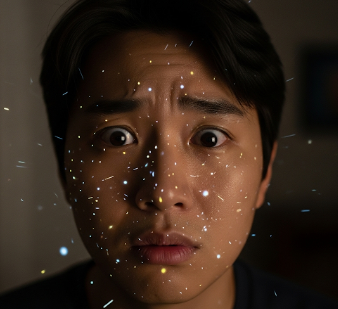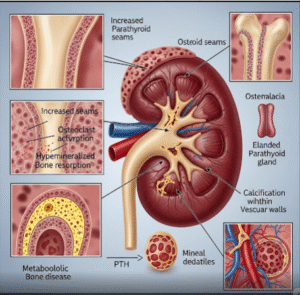Overview
Phosphenes are visual sensations of light without light actually entering the eye. Often described as flashes, sparks, or patterns of light, phosphenes can occur spontaneously or be triggered by pressure on the eyes, sudden eye movements, or even neurological activity. While generally harmless, persistent or sudden-onset phosphenes can sometimes indicate underlying eye or neurological conditions that require evaluation.
➤ Phosphenes can appear as stars, spots, or zigzag patterns in the visual field.
➤ They may occur in one or both eyes, depending on the cause.
➤ Understanding phosphenes is important, as distinguishing benign occurrences from symptoms of serious conditions like retinal detachment is crucial for eye health.
In Korea, ophthalmology and neurology clinics provide advanced diagnostics to assess phosphenes and their underlying causes, ensuring prompt and effective care.
Key Facts
➤ Phosphenes are perceived light without external visual stimuli.
➤ They can be triggered mechanically, electrically, or spontaneously.
➤ Usually, phosphenes are temporary and harmless, but persistent or severe occurrences may signal medical issues.
➤ Common triggers include pressure on the eyes, rapid eye movements, migraines, or fatigue.
➤ Specialized eye care centers in Korea offer high-resolution retinal imaging and neurological assessments to evaluate phosphenes.
What is Phosphenes?
Phosphenes refer to visual phenomena where individuals perceive light in the absence of light stimulation. They are distinct from flashes caused by actual light and can occur in various shapes, colors, and intensities.
➤ Medical definition: The perception of light without actual optical input, caused by mechanical, electrical, or chemical stimulation of the retina or visual cortex.
➤ Types of phosphenes:
➤ Mechanical phosphenes – caused by rubbing or pressing on the eyes.
➤ Migraine-associated phosphenes – often seen as scintillating or zigzag patterns before a headache.
➤ Spontaneous phosphenes – occur without obvious triggers, sometimes linked to retinal or neurological conditions.
➤ Appearance: Phosphenes may manifest as bright spots, flashes, stars, or swirling patterns in the visual field.
Understanding phosphenes can help distinguish between benign causes and symptoms requiring further medical evaluation.
What Symptoms Are Related To
Phosphenes often occur alongside other visual or neurological symptoms, which may provide clues about their underlying cause:
➤ Floaters – small shapes drifting across the visual field, often accompanying retinal issues.
➤ Migraine aura – flashing lights or zigzag patterns preceding a migraine.
➤ Blurred vision – may indicate eye strain or retinal problems.
➤ Headaches – particularly if phosphenes occur in association with migraine.
➤ Sudden loss of vision or dark shadows – may suggest retinal detachment or vitreous hemorrhage.
➤ Eye pain or pressure – can occur with mechanical or vascular triggers.
Identifying related symptoms is essential for determining whether phosphenes are benign or indicative of serious eye or neurological disorders.
What Causes / Possible Causes
Phosphenes can be triggered by mechanical, neurological, or systemic factors:
➤ Mechanical causes:
➤ Rubbing or pressing on the eyes, causing retinal stimulation.
➤ Rapid eye movements, blinking, or changes in eye pressure.
➤ Neurological causes:
➤ Migraines – visual aura with flashing lights or zigzag patterns.
➤ Epileptic activity – some seizures may trigger visual phosphenes.
➤ Optic nerve or visual cortex stimulation due to trauma or lesions.
➤ Ocular causes:
➤ Retinal detachment – sudden flashes or light streaks in peripheral vision.
➤ Posterior vitreous detachment – common in older adults, causing flashes.
➤ High intraocular pressure – can cause transient visual disturbances.
➤ Systemic or environmental factors:
➤ Fatigue, stress, or sleep deprivation.
➤ Low blood pressure or vascular changes reducing retinal perfusion.
➤ Certain medications or toxins affecting neural or ocular function.
While many causes are benign, sudden-onset or recurrent phosphenes warrant medical evaluation to rule out retinal or neurological emergencies.
When Should I See My Doctor
Medical consultation is crucial when phosphenes are sudden, persistent, or accompanied by warning signs:
➤ Sudden appearance of bright flashes or light streaks, especially in one eye.
➤ Floaters, dark shadows, or partial loss of vision accompanying phosphenes.
➤ Headaches, dizziness, or neurological symptoms with visual phenomena.
➤ Persistent or worsening phosphenes over days or weeks.
➤ History of eye trauma, retinal disease, or vascular disorders.
Ophthalmologists in Korea use retinal imaging, optical coherence tomography (OCT), and neurological assessments to identify underlying causes and prevent complications.
Care and Treatment
Treatment focuses on addressing the underlying cause rather than the phosphenes themselves:
➤ Benign phosphenes:
➤ Typically do not require treatment.
➤ Avoid excessive eye rubbing and manage eye strain.
➤ Migraine-related phosphenes:
➤ Preventive medications, hydration, and sleep regulation.
➤ Avoid triggers such as certain foods or stress.
➤ Retinal or ocular causes:
➤ Retinal detachment requires urgent surgical intervention.
➤ Posterior vitreous detachment may only require monitoring unless complications arise.
➤ Lifestyle adjustments:
➤ Reduce screen time and practice visual rest.
➤ Manage stress and fatigue through regular exercise and sleep hygiene.
➤ Monitoring: Regular eye exams ensure early detection of retinal or neurological issues that may manifest as phosphenes.
Treatment Options in Korea
Korean ophthalmology and neurology clinics provide advanced care for phosphenes and related disorders:
➤ Comprehensive eye examinations – including slit-lamp, fundus photography, and OCT.
➤ Retinal surgery – laser therapy or vitrectomy for retinal detachment or vitreous problems.
➤ Migraine and neurology clinics – preventive and acute management for migraine-related phosphenes.
➤ Integrated care programs – combining ophthalmology, neurology, and lifestyle counseling.
➤ Advanced imaging and diagnostics – MRI, CT, and electrophysiological studies for neurological causes.
➤ Patient follow-up and monitoring – ensuring early detection of changes or complications.
Patients in Korea benefit from highly skilled specialists, modern hospital infrastructure, and multidisciplinary care, ensuring phosphenes are properly evaluated and treated when necessary.













